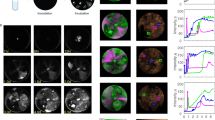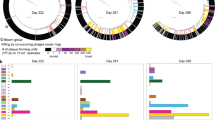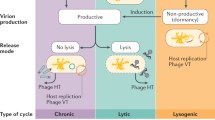Abstract
Coevolution with phages drive the evolution of high bacterial mutation rates in vitro, but the relevance of this finding to natural populations is unclear. Here, we investigated how coevolution affects mutation rate evolution in soil, in the presence and absence of the rest of the natural microbial community. Although mutation rate on average increased threefold, neither coevolving phages nor the rest of natural community significantly affected mutation rates. Our results suggest that features of the soil over and above directly interacting organisms constrain the evolution of strong mutators, helping to explain their relatively low frequency compared with some laboratory and clinical settings.
Similar content being viewed by others
Log in or create a free account to read this content
Gain free access to this article, as well as selected content from this journal and more on nature.com
or
References
Bohannan B, Lenski R . (2000). The relative importance of competition and predation varies with productivity in a model community. Am Nat 156: 329–340.
Buckling A, Hodgson DJ . (2007). Short-term rates of parasite evolution predict the evolution of host diversity. J Evol Biol 20: 1682–1688.
Buckling A, Rainey PB . (2002). Antagonistic coevolution between a bacterium and a bacteriophage. P Roy Soc B Biol Sci 269: 931–936.
Denamur E, Lecointre G, Darlu P, Tenaillon O, Acquaviva C, Sayada C et al (2000). Evolutionary implications of the frequent horizontal transfer of mismatch repair genes. Cell 103: 711–721.
Denamur E, Matic I . (2006). Evolution of mutation rates in bacteria. Mol Microbiol 60: 820–827.
Desai MM, Fisher DS . (2011). The balance between mutators and nonmutators in asexual populations. Genetics 188: 997–1014.
Gandon S, Buckling A, Decaestecker E, Day T . (2008). Host-parasite coevolution and patterns of adaptation across time and space. J Evol Biol 21: 1861–1866.
Giraud A, Matic I, Tenaillon O, Clara A, Radman M, Fons M et al (2001). Costs and benefits of high mutation rates: adaptive evolution of bacteria in the mouse gut. Science 291: 2606–2608.
Gómez P, Buckling A . (2011). Bacteria-phage antagonistic coevolution in soil. Science 332: 106–109.
Hall BM, Ma C-X, Liang P, Singh KK . (2009). Fluctuation analysis calculator: a web tool for the determination of mutation rate using Luria-Delbruck fluctuation analysis. Bioinformatics 25: 1564–1565.
LeClerc JE, Li B, Payne WL, Cebula TA . (1996). High mutation frequencies among Escherichia coli and Salmonella pathogens. Science 274: 1208–1211.
Luria SE, Delbruck M . (1943). Mutations of bacteria from virus sensitivity to virus resistance. Genetics 28: 491–511.
Matic IM, Radman F, Taddei B, Picard C, Doit E, Bingen E et al (1997). Highly variable mutation rates in commensal and pathogenic Escherichia coli. Science 277: 1833–1834.
McDonald MJ, Hsieh YY, Yu YH, Chang SL, Leu JY . (2012). The evolution of low mutation rates in experimental mutator populations of Saccharomyces cerevisiae. Curr Biol 22: 1235–1240.
Oliver A, Canton R, Campo P, Baquero F, Blazquez J . (2000). High frequency of hypermutable Pseudomonas aeruginosa in cystic fibrosis lung infection. Science 288: 1251–1253.
Pal C, Macia MD, Oliver A, Schachar I, Buckling A . (2007). Coevolution with viruses drives the evolution of bacterial mutation rates. Nature 450: 1079–1081.
Rainey PB, Bailey MJ . (1996). Physical and genetic map of the Pseudomonas fluorescens SBW25 chromosome. Mol Microbiol 19: 521–533.
Rosche WA, Foster PL . (2000). Determining mutation rates in bacterial populations. Methods 20: 4–17.
Sniegowski PD, Gerrish PJ, Lenski RE . (1997). Evolution of high mutation rates in experimental populations of E-coli. Nature 387: 703–705.
Tenaillon O, Toupance B, Le Nagard H, Taddei F, Godelle B . (1999). Mutators, population size, adaptive landscape and the adaptation of asexual populations of bacteria. Genetics 152: 485–493.
Vos M, Birkett PJ, Birch E, Griffiths RI, Buckling A . (2009). Local adaptation of bacteriophages to their bacterial hosts in soil. Science 325: 833.
Acknowledgements
We thank two anonymous reviews for comments on the manuscript. The work was supported by European Research Council. PG was supported by a Marie Curie Intra-European Fellowship (PIEF-GA-2010-272945) within the European Union Seventh Framework Programme.
Author information
Authors and Affiliations
Corresponding author
Ethics declarations
Competing interests
The authors declare no conflict of interest.
Additional information
Supplementary Information accompanies this paper on The ISME Journal website
Supplementary information
Rights and permissions
About this article
Cite this article
Gómez, P., Buckling, A. Coevolution with phages does not influence the evolution of bacterial mutation rates in soil. ISME J 7, 2242–2244 (2013). https://doi.org/10.1038/ismej.2013.105
Received:
Revised:
Accepted:
Published:
Issue date:
DOI: https://doi.org/10.1038/ismej.2013.105
Keywords
This article is cited by
-
Community context matters for bacteria-phage ecology and evolution
The ISME Journal (2021)
-
Phage mobility is a core determinant of phage–bacteria coexistence in biofilms
The ISME Journal (2018)
-
Bacteriophages and its applications: an overview
Folia Microbiologica (2017)
-
Local adaptation of a bacterium is as important as its presence in structuring a natural microbial community
Nature Communications (2016)
-
Lytic phages obscure the cost of antibiotic resistance in Escherichia coli
The ISME Journal (2015)



